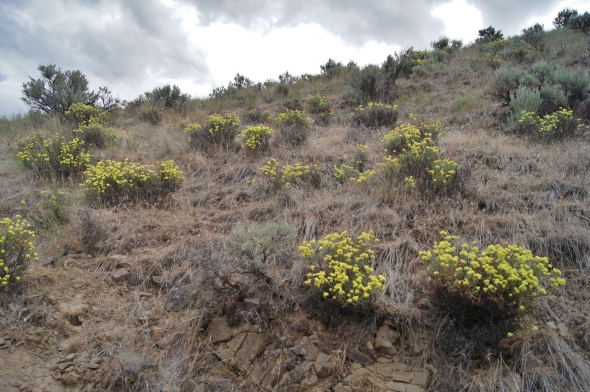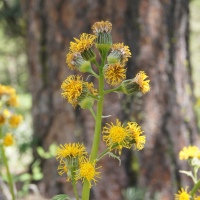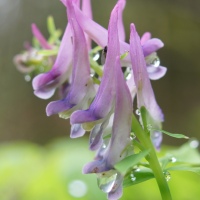Round-Headed Buckwheat (Eriogonum sphaerocephalum)

Umtanum Creek Recreation Area, Yakima River Canyon, WA, 6/2018.
We encountered this bright yellow buckwheat shrub dotting the pale dry sagebrush steppe in the Yakima River Valley in early summer. These blue and grey moth pollinators also joined us at various points in the hike, sometimes in swarms (we think the two colors may indicate we captured both a male and female in our photo). Ronald Taylor (Sagebrush Country; A wildflower sanctuary) indicates that this family are an import nectar source for steppe-inhabiting bees, and food source for birds and rodents. He also notes that the buckwheats, behind only grass and sagebrush (and rabbit brush in its restricted range), are a dominant species of the sagebrush steppe ; adapted, with its long taproot, to thrive in harsh dry rocky environments, and summer drought conditions.

Umtanum Creek Recreation Area, Yakima River Canyon, WA 6/2018.
Although larger than many Eriogonum we see, the flowers are characteristically born in clusters on umbrella-like stems (umbels). Buckwheats have a mix of petals and sepals that give it color. This species has a half dozen extending stamens, with each flower producing a single seed. Also known as Wild Rock Buckwheat, this plant is unique to the pacific northwest, common east of the cascades in low to mid-elevations (3500′ in our photo).
The latin translates to ‘woolly knees’, indicating the height and nature of the efflorescence. These flowers only resemble the true buckwheats (Fagopyrum) a domestic crop with a triangular seed, ground into flour, part of the Polygonaceae family that includes rhubarb, sorrels, and knotweeds.











Leave a comment